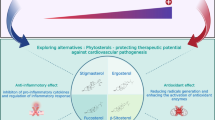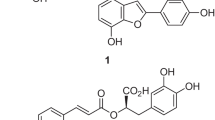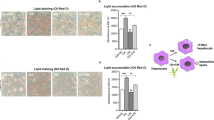Abstract
Objective: To observe the lipid-lowering effect of different transdermal absorption enhancers applied to the herbal cake-partitioned moxibustion in hyperlipidemia model rabbits, and to explore the possible mechanism.
Methods: Forty New-Zealand rabbits were randomly divided into 5 groups using the random number table method, with 8 rats in each group. Rabbits in the blank group were fed routinely with normal diet; rabbits in the other groups were fed with high-fat diet for 12 weeks to establish the hyperlipidemia model. Rabbits in the blank and the model groups were not treated. After the model was prepared, rabbits in the non-transdermal absorption enhancer group received herbal cake-partitioned moxibustion without transdermal absorption enhancer; rabbits in the laurocapram group and the borneol group received herbal cake-partitioned moxibustion with laurocapram or borneol respectively. After 4 weeks of treatment, serum was collected for enzyme-linked immunosorbent assay (ELISA), and the liver tissues were isolated for immunohistochemistry, quantitative polymerase chain reaction (qPCR) and Western-blotting (WB) detection.
Results: Serum ELISA results showed that leptin was significantly decreased in the model group compared with the blank group (P<0.05); compared with the model group, leptin was significantly increased in the non-transdermal absorption enhancer, the laurocapram and the borneol groups (all P<0.05); compared with the non-transdermal absorption enhancer group, leptin was significantly increased in the laurocapram group and the borneol group (both P<0.05); there was no significant difference in leptin between the laurocapram and the borneol groups (P>0.05). The qPCR results of rabbit liver tissues showed that the mRNA expressions of leptin, Janus kinase 2 (JAK2) and signal transducer and activator of transcription 3 (STAT3) in the model group were significantly lower than those in the blank group (all P<0.05); compared with the model group, the mRNA expressions of leptin, leptin receptor (LR), JAK2 and STAT3 in the non-transdermal absorption enhancer, the laurocapram and the borneol groups were significantly increased (all P<0.05); compared with the non-transdermal absorption enhancer group, the mRNA expressions of leptin, LR, JAK2 and STAT3 in the laurocapram and the borneol groups were significantly increased (all P<0.05); compared with the laurocapram group, the mRNA expressions of leptin, LR, JAK2 and STAT3 in the borneol group were significantly increased (P<0.05). The trend of immunohistochemistry and WB detection results was basically consistent with the qPCR assay results. The immunohistochemistry and WB detection results of phosphorylated JAK2 (phospho-JAK2) and phosphorylated STAT3 (phospho-STAT3) were basically consistent with those of JAK2 and STAT3.
Conclusion: The molecular expression of Leptin/JAK2/STAT3 pathway in the hyperlipidemia model rabbits was decreased. The molecular expression of Leptin/JAK2/STAT3 pathway was significantly increased after the herbal cake-partitioned moxibustion. The application of laurocapram and borneol, as transdermal absorption enhancers, in the herbal cake-partitioned moxibustion could more obviously up-regulate the factors of the Leptin/JAK2/STAT3 lipid-regulating pathway than the herbal cake-partitioned moxibustion alone.
摘要
目的: 观察不同促透剂运用于隔药饼灸对高脂模型兔降脂效果的影响, 探讨其可能机制。
方法: 将40只 新西兰兔按随机数字表法随机分成5组, 每组8只。空白组正常喂养普通饲料; 其余组高脂饲料喂养12周, 复制高 脂模型。空白组和模型组不治疗。无促透剂组成模后采用不加促透剂药饼施灸; 氮酮组和冰片组分别将氮酮和冰 片用于药饼中, 进行隔药饼灸。治疗4周后, 分离血清进行酶联免疫吸附测定(ELISA), 分离肝脏组织进行免疫组 化、定量聚合酶链式反应(qPCR)和蛋白免疫印迹(WB)检测。
结果: 血清ELISA检测结果显示, 与空白组比较, 模型 组Leptin显著下降(P<0.05); 与模型组比较, 无促透剂组、氮酮组和冰片组Leptin显著升高(均P<0.05); 与无促透 剂组比较, 氮酮组和冰片组Leptin均显著升高(均P<0.05); 氮酮组和冰片组Leptin差异无统计学意义(P<0.05)。兔 肝脏组织qPCR结果显示, 与空白组比较, 模型组Leptin、JAK2和STAT3 mRNA表达显著降低(均P<0.05); 与模型组比 较,无促透剂组、氮酮组和冰片组Leptin、Leptin受体、JAK2和STAT3 mRNA表达显著升高(均P<0.05); 与无促透剂 组相比, 氮酮组和冰片组的Leptin、Leptin受体、JAK2和STAT3 mRNA表达显著升高(均P<0.05); 与氮酮组比较, 冰 片组的Leptin、Leptin受体、JAK2和STAT3 mRNA表达显著升高(均P<0.05)。免疫组化和WB检测趋势与qPCR结果基本一致。磷酸化JAK2 (Phospho-JAK2)和磷酸化STAT3 (phospho-STAT3)免疫组化和WB检测趋势与JAK2和STAT3基本一 致。
结论: 高脂模型兔的Leptin/JAK2/STAT3通路分子表达下降, 隔药饼灸后Leptin/JAK2/STAT3通路因子表达显著上 升, 氮酮和冰片作为促透剂运用于隔药饼灸比单纯隔药饼灸对Leptin/JAK2/STAT3调脂通路相关因子的上调作用更 明显。
Similar content being viewed by others
References
Wu HG, Yan J, Yu SG, Xu B, Chang XR, Ma XP, Mu JP, Liu HR. Research current situation and development trend of moxibustion therapy. Shanghai Zhenjiu Zazhi, 2009, 28 (1): 1–6.
Ai K, Ai X, Liu M, Chang XR, Zhang L, Fu L, Li JS, Xie H. Influence of moxibustion with herbal cake on total cholesterol and triglyceride in atherosclerotic rabbits. Zhonghua Zhongyiyao Xuekan, 2013, 31 9): 1857–1859.
Yang XW, Li JS, Wu DK, Cai BC. Comparison of the Rhubarb and processed products on eight kinds of components. Xiandai Zhongyao Yanjiu Yu Shijian, 2012, 26 3): 73–75.
Han W, Li XY, Zhou LL, Wu HP, Li SP, Lu Q. Lipid-lowering and anti-aging effects of emodin. Zhongguo Yixue Chuangxin, 2009, 6 29): 14–16.
Wang W, Yang B, Wang L, Liang RX, Chen CY, Hu N, Cheng L, Yang Y, Yin XJ, Gao SR, Ye JX. Antiatherogenic effect of Radix Salviae Miltiorrhizae and Fructus Crataegi on experimental atherosclerosis in rats. Zhongguo Zhongyao Zazhi, 2011, 36 6): 784–789.
Zhang JY. Study of Component Combination with Dan Shen (Radix Salviae Miltiorrhizae)-Shan Zha (Fructus Crataegi) Herb Couple on Anti-atherosclerotic Effects and Its Mechanisms. Beijing: Doctor Thesis of China Academy of Chinese Medical Sciences, 2013.
Chen J, Deng J, Zhang YY, Li JG, Wu FY, Wan HT. Study on regulatory effect of Danshensu on lipid metabolism of hyperlipidemia rats. Zhongguo Zhongyao Zazhi, 2015, 40 2): 313–316.
Huang MY, Wang JX, Shen XJ. Mechanism of tanshinone ?A prohibits apoptosis of vascular endothelial cells. Zhongyi Xuebao, 2013, 28(4): 533–534, 617.
Han M, Gao S, Zhao K. One hundred lipid-lowering medication regularity of Chinese traditional medicine in treating hyperlipidemia. Zhongyiyao Linchuang Zazhi, 2017, 29 2): 217–219.
Niu ZG, Chen HH, Gao CW, Chen GY, Li GN. Chemical constituents from the dregs of Curcuma Wenyujin. Guangdong Huagong, 2014, 41 16): 22–23.
Weng JY, Zhang CC, Lin J, Jin LS, Hu JR, Chen B. Comparative analysis of the curcumin chemical composition in Curcuma Yujin from different origin by HPLC. Zhonghua Zhongyiyao Xuekan, 2015, 33 6): 1393–1395.
Wu YJ, Huang MT, Huang YF, Lai MX, Huang SS, Liu HG. Antihyperliposis effects of ethanol extract from Curcuma Aromatica. Guangxi Kexue, 2015, 22 2): 130–134.
Jin QX. Analysis of the chemical constituents and pharmacological effects of Shan Zha (Fructus Crataegi). Neimenggu Zhongyiyao, 2014, 33 36): 62.
Yang YJ, Lin J, Wang CM, Guo JJ. Experimental study on early intervention of flavonoids in leaves of Shan Zha (Fructus Crataegi) on hyperlipidemia in rats. Zhongcaoyao, 2008, 39 12): 1848–1850.
Liu CY, Liu QN, Zhao J, Zhai LL. Changes of JAK2/STAT3 protein expression in testis of diet-induced obese mice. Shiyong Yufang Yixue, 2018, 25 12): 1413–1416.
Dai XJ, Liang ZJ, Pan JH. The preconditioning effects induced by inflammation on hyperlipidemic rabbits against atherosclerosis. Fudan Daxue Xuebao (Yixue Ban), 2012, 39 1): 42–47.
Li ZR. Experimental Acupuncture Science. Beijing: China Press of Traditional Chinese Medicine, 2007: 242–244.
Liu J, Cui JH. Progress in treatment of hyperlipidemia with traditional Chinese medicine. Tianjin Yaoxue, 2017, 29 3): 70–73.
Qiao JH, Gai GH, Qiao HM, Jia XW, Yang HP, Wang SF. Discussion on pathogenesis and treatment of hyperlipidemia in TCM. Zhongyi Linchuang Yanjiu, 2015(14): 145–147.
Wang WZ, Zhao SM, Gao SZ. Research progress on leptin-mediated JAK/STAT signaling pathway in lipid metabolism. Zhongguo Xibao Shengwuxue Xuebao, 2011, 33 5): 584–589.
Fan CL, Yan J, Qian Y, Wo X, Gao LP. Regulation of lipoprotein lipase expression by effect of hawthorn flavonoids on peroxisome proliferator response element pathway. J Pharmacol Sci, 2006, 100 1): 51–58.
Bartoli M, Al-Shabrawey M, Labazi M, Behzadian MA, Istanboli M, EI-Remessy AB, Caldwell RW, Marcus DM, Caldwell RB. HMG-CoA reductase inhibitors (statin) prevents retinal neovascularization in a model of oxygen-induced retinopathy. Invest Ophthalmol Vis Sci, 2009, 50 10): 4934.
Zheng XR, Wei YH, Song J, Cao N, Wang LF, Ying XP, Hui Y, Zhang EN. The research into influence of cur on leptin stimulating the HSC proliferation and JAK2 and STAT3 information pathway. Henan Zhongyi, 2016, 36 6): 994–995.
Meng XQ, Jiang YH, Wu S, Yang CH. Pharmacodynamic and pharmacological effect of Tribulus Terrestris on kidney of rats with obesity-related hypertension through leptin mediated JAK2/STAT3 pathway. Zhongcaoyao, 2017, 48 3): 539–545.
Vaira S, Yang C, McCoy A, Keya K, Xue S, Weinstein EJ, Novack DV, Cui X. Creation and preliminary characterization of a leptin knockout rat. Endocrinology, 2012, 153 11): 5622–5628.
Mitchell SE, Nogueiras R, Morris A, Tovar S, Grant C, Cruickshank M, Vernon Rayner D, Dieguez C, Williams LM. Leptin receptor gene expression and number in the brain are regulated by leptin level and nutritional status. J Physiol, 2009, 587(Pt 14): 3573–3585.
Liu Y, Tang C. Regulation of ABCA1 functions by signaling pathways. Biochimica Et Biophysica Acta, 2012, 1821 3): 522–529.
Wang J. Study the Lipid-lowering Effect of the Compatibility of Coptis and Evodia Rutaecarpa through Leptin/JAK2/STAT3 Signal Pathway. Chengdu: Master Thesis of Chengdu University of Traditional Chinese Medicine, 2016.
Acknowledgments
This work was supported by Hunan Province College Innovation Open-end Fund Project (湖南省高校创新平台开放基金项目, No. 16K068); 2017 Scientific and Research Innovative Project for Postgraduate Students of Hunan Province (2017 年湖南省研究生科研创新项目, No. CX2017B431).
Author information
Authors and Affiliations
Corresponding author
Additional information
Conflict of Interest
There was no potential conflict of interest in this article.
Statement of Human and Animal Rights
The treatment of animals conformed to the ethical criteria in this experiment.
Rights and permissions
About this article
Cite this article
Liao, Zl., Tan, J., Zhu, Cz. et al. Effect of herbal cake-partitioned moxibustion on Leptin/JAK2/STAT3 in lipid-lowering pathway of hyperlipidemia rabbits. J. Acupunct. Tuina. Sci. 17, 371–382 (2019). https://doi.org/10.1007/s11726-019-1139-2
Received:
Accepted:
Published:
Issue Date:
DOI: https://doi.org/10.1007/s11726-019-1139-2
Keywords
- Moxibustion Therapy
- Indirect Moxibustion
- Herbal Cake-partitioned Moxibustion
- Hyperlipidemias
- Laurocapram
- Janus Kinase 2/Signal Transducer and Activator of Transcription 3 (JAK2/STAT 3) Pathway
- Leptin
- Rabbits




